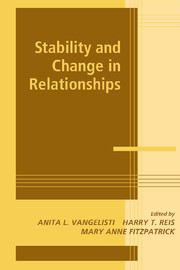PART TWO - BEHAVIORS: THE PROCESSES OF STABILITY AND CHANGE
Published online by Cambridge University Press: 21 October 2009
Summary
Relationships, as defined by Robert Hinde (1979), consist of “intermittent interaction between two people, involving interchanges over an extended period of time.” This definition highlights the importance of examining the behaviors that comprise social interaction, as well as the cognitive and emotional processes that underlie and give meaning to these behaviors. The chapters in this section explore processes involved in interaction between relationship partners and the effects of these processes. Although often bypassed by researchers who instead focus on partners' self-reported affects and cognitions, behavior is nevertheless the linchpin of the relational system because it is through the processes of interacting and communicating that individuals relate to each other. Communication, one class of interaction behavior with special importance for ongoing relationships, is emphasized in several chapters. As readers will see, although all communication is behavior, not all behavior involves communication.
In the first chapter, Roloff and Johnson offer a new twist on an oftstudied behavior: arguing. They begin by noting that although researchers typically treat couples' arguments as limited in scope and duration, many arguments reoccur and may extend over lengthy intervals. These extended conflict episodes are referred to as “serial arguments.” Drawing on previous research to theorize about the antecedents and consequences of serial arguing, Roloff and Johnson lay a foundation for further studies by first defining serial arguments and then explicating their key elements. The authors' careful synthesis of the literature demonstrates the value of examining stability and change in couples' disagreements.
- Type
- Chapter
- Information
- Stability and Change in Relationships , pp. 103 - 106Publisher: Cambridge University PressPrint publication year: 2002



